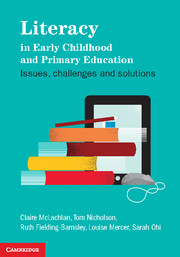Book contents
- Frontmatter
- Contents
- List of figures
- List of tables
- About the authors
- Acknowledgements
- Chapter 1 Introduction
- Part 1 Literacy acquisition: the child, the family and diversity in the modern world
- Chapter 2 Literacy acquisition in the early years: past, present and future
- Chapter 3 When should children start literacy learning?
- Chapter 4 Family literacies and relationships with centres and schools
- Chapter 5 Multiliteracies: growing the next generation of readers
- Chapter 6 Diverse classrooms and learning in bilingual and multicultural/multilingual settings
- Part 2 Learning about literacy in early childhood settings
- Part 3 Literacy learning in the primary school
- Part 4 Literacy learning in the senior primary school
- References
- Index
- References
Chapter 2 - Literacy acquisition in the early years: past, present and future
from Part 1 - Literacy acquisition: the child, the family and diversity in the modern world
- Frontmatter
- Contents
- List of figures
- List of tables
- About the authors
- Acknowledgements
- Chapter 1 Introduction
- Part 1 Literacy acquisition: the child, the family and diversity in the modern world
- Chapter 2 Literacy acquisition in the early years: past, present and future
- Chapter 3 When should children start literacy learning?
- Chapter 4 Family literacies and relationships with centres and schools
- Chapter 5 Multiliteracies: growing the next generation of readers
- Chapter 6 Diverse classrooms and learning in bilingual and multicultural/multilingual settings
- Part 2 Learning about literacy in early childhood settings
- Part 3 Literacy learning in the primary school
- Part 4 Literacy learning in the senior primary school
- References
- Index
- References
Summary
Chapter objectives
To review the history of how literacy has been promoted in the early years, with particular attention to approaches in Australia and New Zealand.
To critically examine the contribution of psycholinguistic and social practice perspectives on literacy acquisition.
To consider the contribution of cultural historical theory to current thinking about literacy acquisition.
This chapter outlines recent theory and research on literacy acquisition. It involves a brief review of the psycholinguistic research into how children gain the essential literacy skills that predict reading achievement (in particular phonological awareness and alphabet knowledge). It also reviews the social practice research showing that children have different pathways to literacy as a result of their immersion in diverse social and cultural settings. Using a sociocultural framework, this chapter explores how children acquire literacy as a result of both access to and mediation of literacy in homes, communities, early childhood settings and schools.
Looking back: a brief history of literacy in the early years
Nicholson (2000) provides a compelling history of the teaching of reading in his text ‘Reading the Writing on the Wall’, which outlines that humans have been using symbol systems to communicate for thousands of years. He cites evidence that alphabet (ABC) methods of teaching reading have been used for around 3000 years. Certainly this method of teaching reading prevailed in Australia and New Zealand through their respective periods of settlement into the late 19th century. It has only been in more recent history, however, that the notion of everyone being able to read and write has gained social and cultural acceptance. From feudal times, the main people who were likely to be literate were wealthy and male or belonged to a religious order. We will discuss New Zealand’s history of reading instruction as an example of the changes over time, as the differences between states in Australia make presenting a simple history quite difficult.
- Type
- Chapter
- Information
- Literacy in Early Childhood and Primary EducationIssues, Challenges, Solutions, pp. 19 - 34Publisher: Cambridge University PressPrint publication year: 2012



